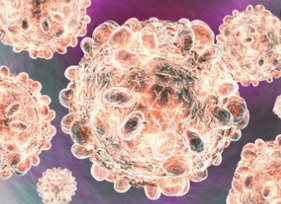Metabolomics in HCV Infection
Metabolomics analysis is a new technology to investigate the metabolites produced by or altered in an organism, which provides a valuable approach for the study of complex diseases. Metabolomics can link genotype and phenotype, and analysis of specific patterns of metabolic alterations associated with HCV infection have been exploited for HCV diagnosis and disease staging.

Hepatitis C virus (HCV)
Hepatitis C virus (HCV), a single strand RNA virus, is a major cause of chronic liver disease. Liver damage caused by HCV-chronic infection can be assessed using different methods. Among them, the most commonly used METAVIR score can classify fibrosis stages into F0, F1-2, F3 and F4 grades, ranging from non-fibrosis to cirrhosis. Cirrhosis, as the end-stage of every chronic liver disease, carries a main risk of progression to hepatocellular carcinoma (HCC). In recent years, anti-HCV treatment has made great progress, such as the use of new direct-acting antivirals (DAAs) treatment.
Metabolomics applications in HCV
1H-NMR metabolomics for HCV diagnosis and disease staging
Although liver biopsy is the current gold standard for HCV-induced fibrosis and cirrhosis diagnosis, the method still has limitations due to invasiveness, technical issues, and so on. Therefore, a number of complementary non-invasive methods have been developed to monitor and diagnose liver fibrosis progression, including physical approach (e.g., diagnostic or ultrasound imaging techniques) and biological approach (e.g., metabolomics profiling approach). Metabolomics profiling approach that provides information on metabolic changes associated with disease processes. As one of the main analytical tools used in metabolomics, the proton nuclear magnetic resonance (1H-NMR) metabolomics profiling approach has been applied to stratify HCV-related liver histological disease progression by analyzing serum metabolites. Combined with multivariate statistical analysis, it was possible to distinguish between different stages of liver fibrosis, necroinflammation, and steatosis can be discriminated by identifying non-invasive metabolite biomarkers.
Investigate the differences in plasma metabolites between HCV-induced cirrhosis and HCC
Hepatocellular carcinoma (HCC) is the second leading cause of cancer-related mortality and its incidence is increasing. Cirrhosis caused by chronic viral hepatitis B or C is considered to be a major risk factor for HCC worldwide. Due to few symptoms appearing before advanced HCC and the absence of early diagnosis of biomarkers for HCC, the diagnosis of HCC is late, leading to high mortality rates. To discern the HCV-cirrhotic group and HCC group, a non-targeted metabolomic analysis was applied to investigate plasma metabolites in both groups. Notably, there were five metabolites identified with the strongest discriminatory power for distinguishing, including caprylic acid (a medium-chain saturated fatty acid), capric acid (a medium-chain saturated fatty acid), oxalic acid (a saturated dicarboxylic acid), oleic acid (a monounsaturated fatty acid), and glycine. The study highlighted the metabolomics investigation, particularly involving fatty acids, may help distinguish HCV-induced liver cirrhosis from HCC patients.
Metabolomics has emerged as a powerful tool in studying mechanisms of different diseases, providing ample information on disease pathogenesis, diagnosis as well as personalized treatment. Creative Proteomics has been developing metabolomics detection methods and data analysis methods for many years. Based on professional scientists and advanced platforms, we can accelerate our customers' projects to the next level. For more information on how we can help you, please feel free to contact us.
References
- Sarfaraz, M. O., et al. (2016). "A quantitative metabolomics profiling approach for the noninvasive assessment of liver histology in patients with chronic hepatitis C." Clinical and translational medicine, 5(1), 1-13.
- Nomair, A. M., et al. (2019). "Profiling of plasma metabolomics in patients with hepatitis C-related liver cirrhosis and hepatocellular carcinoma." Clinical and experimental hepatology, 5(4), 317.
Related services
* For research use only.

